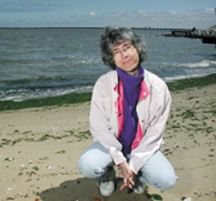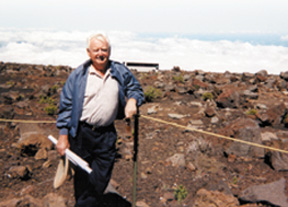Geotimes

Society Page
News
about people and
announcements from
AGI's 40 member societies
|
By
Christina Reed
To post news in Society Page, send e-mail to geotimes@agiweb.org
with the subject: Society Page. |
Contents:
Journalism awards
out of this world
The American Geophysical Union (AGU) presented Richard Monastersky, senior
writer for science topics at The Chronicle of Higher Education, and Diane Tennant,
staff writer for The Virginian-Pilot, the 2002 awards for excellence in
science journalism on May 29 during its spring meeting in Washington.
 Following up on
a tip from a friend at the Virginia Museum of Natural History, Tennant went beyond
the press releases and media conferences to learn why the U.S. Geological Survey
(USGS) was drilling the site of a buried impact crater on NASA property in southeastern
Virginia. She visited with David Powars of the USGS and immediately knew she was
on to something larger than a one-day news story.
Following up on
a tip from a friend at the Virginia Museum of Natural History, Tennant went beyond
the press releases and media conferences to learn why the U.S. Geological Survey
(USGS) was drilling the site of a buried impact crater on NASA property in southeastern
Virginia. She visited with David Powars of the USGS and immediately knew she was
on to something larger than a one-day news story.
Diane Tennant along the James River near her home in Chesapeake, Va. Photo by
Dennis Tennant
“He just started talking and he waved his hands and got on his toes and he
was so engaging. I thought, what a great character for a story,” Tennant
says.
But the Norfolk-based Virginian-Pilot had already run a story on the subject.
Tennant, who has worked at the newspaper since 1985, convinced her editors she
needed more space and time. “The research was better than one story,”
Tennant says. “It had groundwater and earthquakes, and trapped air that NASA
is trying to study, and cool stuff from 35 million years ago. The challenge was
making groundwater interesting.”
After nine months of research, Tennant produced a seven-part series published
June 24-30, 2001. Based on the first three parts of “A Cosmic Tale,”
Tennant won the Walter Sullivan Award for features.
 Monastersky won the
David Perlman Award for his news story “A Plucky Spacecraft Explores a Distant
Asteroid,” published March 2, 2001. “I’d never watched a spacecraft
land on an alien world before,” Monastersky says. “And I wasn’t
reporting during the Moon landing,” he laughs. When the Near Earth Asteroid
Rendezvous (NEAR) Shoemaker probe landed softly on Eros last year, Monastersky
witnessed the event surrounded by scientists, engineers and other journalists
in the auditorium at the Johns Hopkins laboratory in Laurel, Md. Monastersky followed
the story of the “plucky” probe’s adventure to the distant asteroid
and its unexpected survival after the landing.
Monastersky won the
David Perlman Award for his news story “A Plucky Spacecraft Explores a Distant
Asteroid,” published March 2, 2001. “I’d never watched a spacecraft
land on an alien world before,” Monastersky says. “And I wasn’t
reporting during the Moon landing,” he laughs. When the Near Earth Asteroid
Rendezvous (NEAR) Shoemaker probe landed softly on Eros last year, Monastersky
witnessed the event surrounded by scientists, engineers and other journalists
in the auditorium at the Johns Hopkins laboratory in Laurel, Md. Monastersky followed
the story of the “plucky” probe’s adventure to the distant asteroid
and its unexpected survival after the landing.
Richard Monastersky works on assignment
for National Geographic magazine along Yellowstone River. Here, he interviews
Anna-Louise Reysenbach, a Portland State University professor who studies extremophiles.
Photo courtesy of R. Monastersky
AGU recognized Monastersky’s work for his vivid description of the scientific
importance of the mission, as well as showing the fiscal constraints and human
interactions that shaped the mission’s success.
Read Tennant’s “A Cosmic Tale” on The
Virginian-Pilot Web site. Monastersky’s “A Plucky Spacecraft Explores
a Distant Asteroid” is on the Chronicle
of Higher Education site.
Public Service Award
for teaching evolution
Eugenie Scott has done it again. A recipient of the 2001 Geological Society
of America’s Public Service Award, Scott was awarded the 2002 Public Service
Award from the National Science Board (NSB) on May 7 for increasing public understanding
of science and engineering.
Scott, a physical anthropologist, has been the executive director for the National
Center for Science Education, based at the University of California, Berkeley,
since 1987. She has worked to raise the level of consciousness about teaching
evolution in U.S. public schools.
Scott shares the honor with the Society for Advancement of Chicanos and Native
Americans in Science (SACNAS), an organization that promotes diversity in science
careers for underrepresented Latinos and Native Americans.
“SACNAS and Eugenie Scott have had a profound impact on influencing and
encouraging a new and more diverse group of next-generation scientists and engineers,”
says NSB Chairman Eamon Kelly. “They have built career-developing and career-enhancing
programs, and a body of thought within our K-12 public school systems promoting
progressiveness and inclusiveness.”
Shifting gears
The United States Thunderbirds flew over Europe after World War
II, demonstrating the aerobatic techniques of the U.S. Air Force. In 1947, Bill
Crain worked hard as the crew chief for the Thunderbirds. He fixed the Air Force
fighter jets: the F-80 shooting star, the F-84 and the F-86. He longed to fly
for the Air Force; he had his pilot’s license, but at 17 years old the
mechanic had a year to go before he could apply for flying school.
 Then the rules
changed and, at age 18, Crain needed two years of college to pursue his dream.
He was fresh out of high school traveling Europe with flying aces. Rather than
leave the Thunderbirds, he finished his three-year commitment with the Air Force
before turning to the University of Minnesota in Duluth.
Then the rules
changed and, at age 18, Crain needed two years of college to pursue his dream.
He was fresh out of high school traveling Europe with flying aces. Rather than
leave the Thunderbirds, he finished his three-year commitment with the Air Force
before turning to the University of Minnesota in Duluth.
Bill Crain stands atop Haleakula in Hawaii.
Crain retired from Chevron as a director and vice president in charge of worldwide
exploration and production.
In the spring of 1953, Crain was ready to graduate and move on to flying school.
But he had one science credit he had to fill before he could receive his bachelor’s
degree in business and economics. He chose a course in geology with professor
Robert Heller.
Crain changed his mind and decided to become a geologist. “I’m an
outdoors person,” Crain says. “The general geology course Bob taught
fascinated me. He was charismatic and lit up like a light bulb whenever he had
a rock in his hand. We would take field trips around Lake Superior, and I switched
to geology because of his overall enthusiasm and dedication as an educator.”
But in order to get into graduate school in geology, Crain needed a few more
science credits. That summer, he got married and went back to college. “I
took all my geology courses from Bob Heller.” After two years, Crain had
two bachelor’s degrees and two kids to boot. He and his family moved to
Minneapolis where Crain earned his master’s degree in geology metallurgical
engineering. Crain then began a lifelong career as a geologist with Chevron.
In March, the American Geological Institute (AGI) awarded Crain and the
late Bob Heller its William B. Heroy Jr. Award for distinguished service. Together
Crain and Heller generated the vision and support for AGI’s inquiry-based,
secondary-school Earth science curricula.
In 1992, Heller had contacted Crain with a proposal. “He came to me dissatisfied
with high school textbooks on geology,” Crain says. “He was interested
in inquiry-based teaching, not handing the students stuff to memorize.”
Crain had the contacts at Chevron to help fund the project.
In 1993, however, Heller died from cancer. Three years ago, Crain saw the development
of the project come to fruition after leading an AGI Foundation drive to raise
$2.5 million in support of the new curriculum. “Bob gave me 12 principles
to embody in geologic education, and AGI was active in working with NSF in developing
these principles,” Crain says. “He set me on the path to raise the
money, and we achieved what he had envisioned.”
AGI’s Investigating Earth Systems is now adopted in 26 states. Middle-school
teachers can use the nine-unit program as a full course presented in any order
or as stand-alone modules in class. The initiative also jump-started AGI’s
high school curriculum, EarthComm, and a teacher’s guide for Investigating
Earth Systems.
“You know a lot of geologists became what they are because of an enthusiastic
and gifted educator,” Crain says. The key is exposure. “And that’s
true in other fields as well, it happens quite often throughout education. I
encouraged my own children to take as wide a variety of courses as they can,
to find out what they really like. If you pick a career based on what you really
like to do and not because of money and what not, you’ll succeed because
you’ll be doing what you enjoy.”
 Then the rules
changed and, at age 18, Crain needed two years of college to pursue his dream.
He was fresh out of high school traveling Europe with flying aces. Rather than
leave the Thunderbirds, he finished his three-year commitment with the Air Force
before turning to the University of Minnesota in Duluth.
Then the rules
changed and, at age 18, Crain needed two years of college to pursue his dream.
He was fresh out of high school traveling Europe with flying aces. Rather than
leave the Thunderbirds, he finished his three-year commitment with the Air Force
before turning to the University of Minnesota in Duluth. 
 Following up on
a tip from a friend at the Virginia Museum of Natural History, Tennant went beyond
the press releases and media conferences to learn why the U.S. Geological Survey
(USGS) was drilling the site of a buried impact crater on NASA property in southeastern
Virginia. She visited with David Powars of the USGS and immediately knew she was
on to something larger than a one-day news story.
Following up on
a tip from a friend at the Virginia Museum of Natural History, Tennant went beyond
the press releases and media conferences to learn why the U.S. Geological Survey
(USGS) was drilling the site of a buried impact crater on NASA property in southeastern
Virginia. She visited with David Powars of the USGS and immediately knew she was
on to something larger than a one-day news story.  Monastersky won the
David Perlman Award for his news story “A Plucky Spacecraft Explores a Distant
Asteroid,” published March 2, 2001. “I’d never watched a spacecraft
land on an alien world before,” Monastersky says. “And I wasn’t
reporting during the Moon landing,” he laughs. When the Near Earth Asteroid
Rendezvous (NEAR) Shoemaker probe landed softly on Eros last year, Monastersky
witnessed the event surrounded by scientists, engineers and other journalists
in the auditorium at the Johns Hopkins laboratory in Laurel, Md. Monastersky followed
the story of the “plucky” probe’s adventure to the distant asteroid
and its unexpected survival after the landing.
Monastersky won the
David Perlman Award for his news story “A Plucky Spacecraft Explores a Distant
Asteroid,” published March 2, 2001. “I’d never watched a spacecraft
land on an alien world before,” Monastersky says. “And I wasn’t
reporting during the Moon landing,” he laughs. When the Near Earth Asteroid
Rendezvous (NEAR) Shoemaker probe landed softly on Eros last year, Monastersky
witnessed the event surrounded by scientists, engineers and other journalists
in the auditorium at the Johns Hopkins laboratory in Laurel, Md. Monastersky followed
the story of the “plucky” probe’s adventure to the distant asteroid
and its unexpected survival after the landing. 